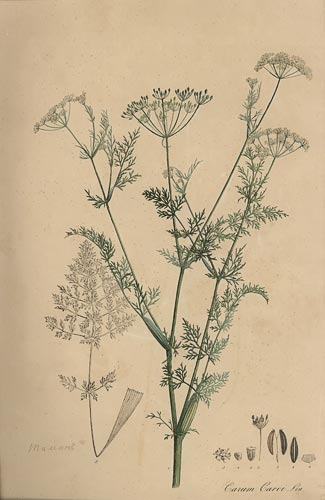Relatives
Carum carvi L. - Caraway.
Taxonomic position.
Family: Apiaceae (Umbelliferae Moris.); genus: Carum L.Morphology and biology.
Biennial or perennial plant. The whole plant is alaberous. Root is fusiform or cylindrical, fleshy. Stem is straight, branchy in the upper part, 30-80 cm high. Leaves are oblong in shape; lower ones set on long stalks, upper ones on short stalks that widen at the base into a white-pink sheath with membranous edges. Leaf blades are 6-15 cm long and 2-8 cm wide, bipinnate or tripinnate; their primary lobes are sessile, ovate-lanceolate, acuminate, incised into narrow, almost linear acute lobules 3-7 mm long and 1-1.5 mm wide. Umbels with 8-16 naked unequal rays are 4-8 cm in diameter. Bract is absent or may consist of 1-2 leaflets. Involucels are absent. Denticles of the calyx are imperceptible. Petals are white or pinkish, broad, obovate in shape, about 1.5 mm long. Styles are revolute. Fruit are about 4 mm long and 2.5 mm wide. Blossoms in June/July, bears fruit in August. 2n=20. Insect pollinated.Distribution.
Worldwide distribution: Central and Atlantic Europe; Mediterranean region; Northern Africa; the Balkans and Asia Minor; Armenia-Kurdistan region; Iran; China (Xinjiang); Mongolia; and the Himalayas. Naturalized in North America and New Zealand. Within the Former -Soviet Union: European part (Karelia-Lapland, Ladoga-Ilmen, Dvina-Pechora, Near-Baltic, Volga-Kama, Upper- and Middle-Dnieper, Upper-Volga, Volga-Don and Trans-Volga regions); Caucasus (all areas); Western and Eastern Siberia (all areas); Far East (Kamchatka); Middle Asia (Tien Shan, Pamir-Altai and Turkmenistan).Ecology.
In meadows, sometimes on solonetz soils; in sparse coniferous and mixed forests and on forest outskirts; near roads and homesteads; weedy in crop fields; in the mountains grows up to 4,000 m.Utilization and economic value.
Caraway fruit are widely used in cookery because of their peculiar aroma. Essential oil is extracted from fruit by distillation. Oil is colorless when fresh and acquires yellowish color during storage; it has a distinctive caraway smell and spicy flavor. Principal components of this oil are the cetone, carvon (50-65%) and the terpene, limonene (35-55%). Caraway oil is widely utilized in the soap industry and alcoholic beverage production. After oil distillation, fruit contain 12-14% fat and 20-25% protein and may serve to produce inedible fatty oils; waste products are a good feed for livestock. Plant breeders in the USSR have developed annual caraway varieties, thus making yearly harvests possible. Caraway had been domesticated in Europe since the middle to late Neolithic period. At present it is cultivated practically in all European countries and other parts of the world.Reference Citations:
Cherepanov S.K. 1995. Plantae Vasculares Rossicae et Civitatum Collimitanearum (in limicis USSR olim). St. Petersburg: Mir I Semia. 990 pp. (In Russian)Grossgheim, A.A. 1967. Flora of Caucasia. Leningrad: Nauka. V. 7: 311. (In Russian)
Malyshev, L.I. & G.A. Peshkova, ed. 1979. Flora of the Central Siberia. Novosibirsk: Nauka. V.2: 678.
Ramenskaya M.L. 1983. Manual of the vascular plants of Murmansk district and Karelia. Moscow-Leningrad: Nauka. 95-97 pp. (In Russian)
Shishkin, B.K., ed. 1950. Flora USSR. Moscow-Leningrad: Publishing House of the USSR Academy of Sciences. V.16: 386. (In Russian)
Tolmachev A.I., ed. 1983. Atlas of areas and resources of medicinal plants of the USSR. Moscow. 120-121, 313 pp. (In Russian)
Tsvelev N.N. 2000. Manual of the vascular plants of North-West Russia (Leningrad, Pskov and Novgorod district). St. Petersburg: Publishing House of SPHFA. 511 pp. (In Russian)


